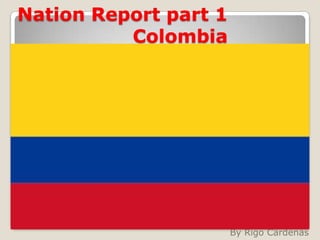
Colombia's Regions and People
- 1. Nation Report part 1 Colombia By Rigo Cardenas
- 2. Geography Colombia is characterized by containing five main natural regions that present their own unique characteristics, from the Andes mountain range region shared with Ecuador and Venezuela. Colombia is the only South American country which borders both the Atlantic and Pacific Oceans. Colombia is located in the northwestern region of South America bordering to the east with Venezuela and Brazil; to the south with Ecuador and Peru; to the North with the Atlantic Ocean, through the Caribbean Sea and to the west with Panama and the Pacific Ocean. Colombia was one of the three countries that emerged from the collapse of Gran Colombia in 1830.
- 3. Geography The complicated nations of Venezuela, Colombia and Ecuador have been grouped together, from 1740, as the Spanish viceroyalty of New Granada with the collateral at Bogotá. A four-decade long conflict between government forces and anti-government insurgent groups, principally the Revolutionary Armed Forces of Colombia (FARC) heavily funded by the drug trade, escalated during the 1990s. Colombia usually classifies its geography into five regions. The eastern half is a low, jungle-covered plain, drained by spurs of the Amazon and Orinoco Rivers, inhabited mostly by isolated tropical-forest Indian tribes.
- 4. People About 60% of Colombia's population are mestizos, and some one fifth are of European descent. Indigenous peoples, who account for only about 1% of today's population, live on the edge of some of the major cities and in remote areas. About 15% of the people are of mixed African and European descent.
- 5. People The country is urbanized as over 76 per cent of the population lives in towns and cities. The Colombian people are very, very special. You'll rarely find such joyful, open-hearted, skilled and inspiring people in South America. In fact for us they are THE highlight of Colombia if not whole South America.Colombian population reached 44 million in late 2002 and the population density varies a great deal across the country. In Bogotá the estimated population varies between 7 and 10 million inhabitants. The population has significant racial integration and about 75% is mixed blood. Roughly the population can be divided in 4 groups: Mestizos (50%), mixed Indian with European, Mulatos (20%), European with African blood, Zambos (5%) African with Indian blood and the rest of the population is pure White, Black or Indian.
- 6. Culture The art and culture of Colombia touched the peak around the 16th century, which is even before the Spanish settlers came in. The folk music and dance of the country reveals African or Native American influences. Bambuco, the national dance is quite famous but Salsa is also equally popular. The music loved by most people in Colombia is called murga, which is played by groups of wandering street musicians using stringed instruments. The country also excels in art and craft work. The temples, statues, potteries that are made here are the examples of the fine artwork of Colombians. The culture of Colombia has traces of Native Americans. In Bogotá and the Andean region, ajiaco is a traditional dish. It is a soup made of chicken, corn, many different types of potatoes, avocado, and guascas, a local herb. Traditionally, cream and capers are added at the table before eating.
- 7. Culture Many aspects of Colombian culture can be traced back to the early culture of Spain of the 16th century and its collision with Colombia's native civilization. The rapid phase of urbanization has led to the usherance of a cosmopolitan culture in Columbia and the effects of it are widely felt in different spheres of Columbian culture. The rich legacy of the Castilian heritage still continues to dominate the ethnicity of the country. During the 1940s, Colombia started to develop its tourist industry having as main attraction the Caribbean coastal city of Santa Marta and the Magdalena river basin main towns which also had a flourishing economy and an important flow of immigrants from Europe and the Middle East due to World War I.
- 8. History After the Spanish conquest, which began in 1525, the area of present-day Colombia formed the nucleus of New Granada From 1974 until 1982, different presidential administrations chose to focus on ending the persistent insurgencies that sought to undermine Colombia's traditional political system. Both groups claimed to represent the poor and weak against the rich and powerful classes of the country, demanding the completion of true land and political reform, from an openly Communistperspective. Prior to the Spanish conquest, Colombia was inhabited by Chibcha, sub-Andean, and Caribbean peoples, all of whom lived in organized, agriculturally based communities.
- 9. History The Spanish settled along the north coast of today's Colombia as early as the 1500s, but their first permanent settlement, at Santa Marta, was not established until 1525. Colombia has a long history going back before the Spanish Conquest, and there are several sites that bear testimony to its fascinating Indian past. In San Agustín, in the southern part of the Colombian Andes, monoliths of volcanic stone representing gods and warriors are preserved, and nearby, in the area of Tierradentro, the visitor can enter a complex of underground burial chambers Towards the third decade of the 16th century, the founding of the main towns commenced. Land was distributed among the conquerors, the exploitation of the salt, gold and emerald mines was organized and Christianity was established. Coexistence between the Spanish colonizers and their African slaves gave rise to a process of mestizaje.
- 10. Sources http://en.wikipedia.org/wiki/History_of_Colombia. http://www.colombia.travel/en/international-tourist/colombia. http://www.colombia.travel/en/international-tourist/colombia.